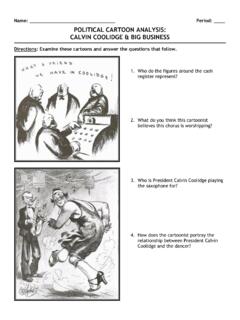Transcription of Cartoon violence and aggression in youth - Geneseo
1 Cartoon violence and aggression in youthSteven J. Kirsh Department of Psychology, SUNY- Geneseo , Geneseo , NY 14454, United StatesReceived 4 October 2005; accepted 7 October 2005 Available online 28 November 2005 AbstractThis manuscript reviews the literature concerning the effects of animated violence on aggressive behavior in youth . It beginswith an overview of the research on children's and adolescents' perceptions of violence in cartoons. Next, the effects of cartoonviolence on aggressive behavior across development are reviewed. In each section, the importance of the presence (or absence) ofcomedic elements in animated violence is addressed. Moreover, throughout the review, the potential influence of development isconsidered. Finally, a potential mechanism for reducing the negative influence of Cartoon violence on youth is considered.
2 2006 Published by Elsevier : Cartoon violence ; Aggressive behavior; YouthContents1. Cartoon violence and aggression in 5482. Violent elements in 5483. Comedy and the perception of Cartoon Factors that lead to the trivialization of comedic Cognitive Schematic Contextual The role of 5504. Non-comedic cartoons and perceived Perceived Perceived Perceived 5515. Cartoons and aggressive behavior: the Laboratory research in early Field experiments in early Research on middle Research on 554 aggression and Violent Behavior 11 (2006) 547 557 Tel.: +1 585 245 5215; fax: +1 585 245 address: - see front matter 2006 Published by Elsevier Limiting the effects of Cartoon violence on 5547. 5561.
3 Cartoon violence and aggression in youthChildren have been entertained by animated films and television shows for over 80 years. The first true animatedstar was the 1920s icon,Felix the Cat. Within the next 10 years, characters developed by the Disney Brothers' CartoonStudios, such as Mickey Mouse, Donald Duck, and Pluto had become international celebrities and their movies weregenerating millions of dollars. In fact,Disney'sfirst full feature length film,Snow White and the Seven Dwarfs, is stillone of the top ten grossing films of all time, when adjusted for inflation (Box Office , 2004). By the 1950s,the violence -laden Cartoon ,Popeye the Sailor, was drawing a large television audience. Following the success ofPopeye, studios such as Hanna Barbera began to produceThe Flinstonesand other made-for-TV animated series (seeKirsh, 2006for a more detailed review of the history of violence in the media).
4 Currently, animated film classics andnew television series can be seen on cable/satellite channels, such as Boomerang, Cartoon Network, and The DisneyChannel. Moreover, feature films staring animated characters are still box office juggernauts. For instance, in 2004,Shrek 2generated nearly $900 billion in international box office receipts and billions more in home DVD sales (BoxOffice , 2004).2. Violent elements in cartoonsViolence in cartoons is an integral part of Cartoon content. In fact, frequency of violence in cartoons is higher thanin live-action dramas or comedies (Potter & Warren, 1998). As a consequence, youth are more likely to view media-depicted violence during Saturday morning cartoons than during prime-time television hours (8:00 11:00 ;Gerbner, Gross, Morgan, & Signorelli, 1994).
5 However, there are qualitative differences between the acts of violencedepicted during live-action dramas and those depicted in cartoons. Cartoon violence meant for a youthful audience (asopposed to animated films for adults, such asHeavy Metal) tend to involve minor acts of violence : realisticallyportrayed death is rarely shown and graphic acts of violence are seldom televised. Additionally, cartoons sanitize theoutcomes of violence , in that it is unusual to see the victims suffering in a life-like manner. In contrast, live-actiondramas airing during prime-time regularly involve major acts of violence ( , rape and murder), and the pain andsuffering of the victim is often highlighted (Potter & Warren, 1998).Although many violent cartoons meant for youthful consumption contain comedic elements ( ,Woody Wood-pecker,Scooby Doo), some of these cartoons just portray the violence .
6 For instance,Samurai Jack,X-Men Evolution,andBatman: The Animated Seriesdepict animated violence , with little to no comedic elements. Moreover, for thesetypes of animated shows, violence is found at the beginning and end of disputes. Presence or absence of comedyduring violence is an important consideration when evaluating the effects of viewing cartoons on youth , for there isboth theory and research to support the contention that comedic elements may camouflage and trivialize depictions ofviolence (King, 2000; Potter & Warren, 1998).3. Comedy and the perception of Cartoon violenceFew studies have assessed the impact of comedic elements on children's and adolescents'perceptionofviolence depicted in television shows and in films. Moreover, the studies that have been conducted haveproduced contradictory findings.
7 For instance,Snow (1974)had youth evaluate cartoons, live-action dramas,and news footage of the Vietnam War for presence of violence . Violent elements in cartoons were consistentlyoverlooked, with only 27% of 4- to 8-year-olds and a mere 16% of 9- to 12-year-olds correctly identifying thatthe Cartoon ( ,Roadrunner) they had just watched contained violence . In comparison, nearly 70% of youth inSnow's sample classified the television WesternGunsmokeas containing violence . Regardless of age, all childrencorrectly identified news clips of the Vietnam War as containing violent imagery. In contrast, in an investigationof 5th and 6th grade boys and girlsHaynes (1978)found that cartoons with comedic elements were perceived Kirsh / aggression and Violent Behavior 11 (2006) 547 557more violent than cartoons without comedic elements, even though both cartoons contained the same amount on adults' perceptions of humorous cartoons have been and Cumberbatch (1975)foundthat most adults do not perceive humorous cartoons as violent.
8 Similarly,Gunter and Furnham (1984)found violencedepicted in humorous cartoons is perceived as less violent than the same behavior enacted by live actors. Given thecontradictory findings and paucity of research using children, more studies are needed to establish developmental factsregarding the perception of violence in comedic and non-comedic cartoons across development. Despite lack ofevidence suggesting that children perceive humorous cartoons as less violent than other media forms, there aretheoretical reasons to believe that comedy does, in fact, camouflage or trivialize depictions of Factors that lead to the trivialization of comedic Cognitive transformationHumorous elements in cartoons are thought to signal viewers that seriousness of the events they are watchingshould be down played.
9 As a result, a cognitive transformation occurs, rendering material that might otherwise beconsidered grave as whimsical (Kane, Suls, & Tedeschi, 1977). With regard to depictions of aggression , in the contextof humor such acts are transformed from solemn and gruesome events into comical ones. In fact, the more the violencedeviates from reality (as is the case in cartoons, science fiction, and fantasy), the less likely it is that the act of violencewill be taken seriously by the (2003)suggests that in order for viewers to perceive violence in media, afeeling ofpersonal threatmust occur. For instance, if the viewing of a homicide causes an individual to worry abouthis or her own safety, then the violence that caused the murder will be perceived. Given that comedic cartoons deviatesignificantly from reality, and it is therefore difficult for the viewer to make a connection between the onscreenviolence and a personal threat of violence , the level of violence associated with the viewed media is Schematic processingSchemas are cognitive structures that organize responses to experiences (Fiske & Taylor, 1991).
10 With each newencounter, schemas are thought to guide us through the experience by providing a template of expectations for rules,behaviors, and outcomes. According toPotter and Warren (1998), schemas are formed for different media genres, suchas westerns, action/adventure, drama, and comedy. Schemas for comedies are thought to contain expectations andrules regarding the type and pacing of jokes, the variety of characters involved, and the typical schemas are updated for accuracy, such modifications rarely take place in situations of low such instances, minor discrepancies between the experience and the schema are ignored, and the schema isapplied to the situation in an all-or-none fashion. Thus, any elements within the show that contradict the expectedpattern are not processed. However, large discrepancies between the show and the schema can effect a change in and Warren (1998)suggest that viewing of comedic television is a low-involvement activity for such, minor discrepancies between the program and the schema are ignored because the schema is being applied inan all-or-none manner.

















